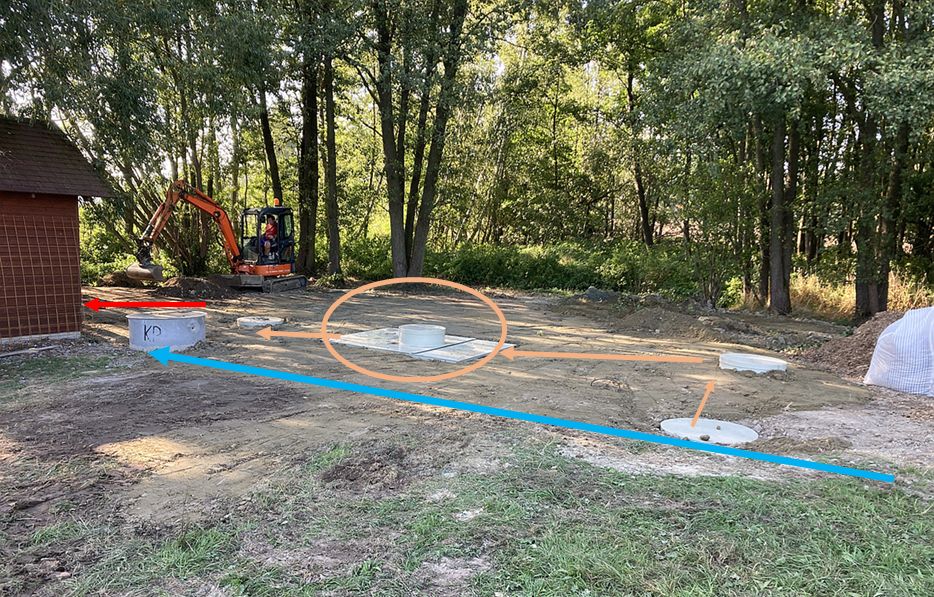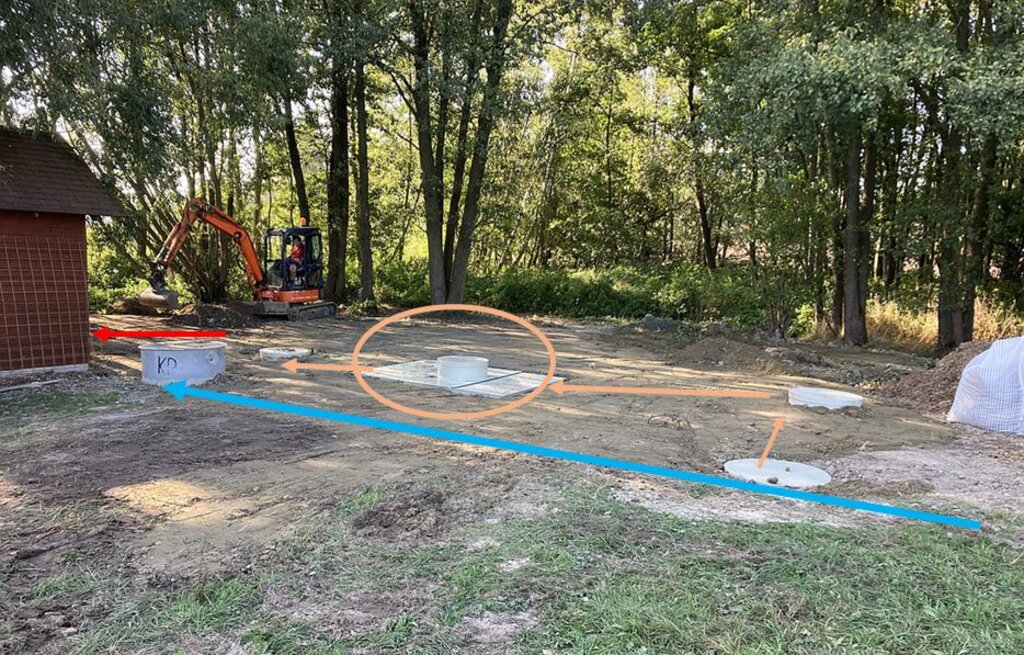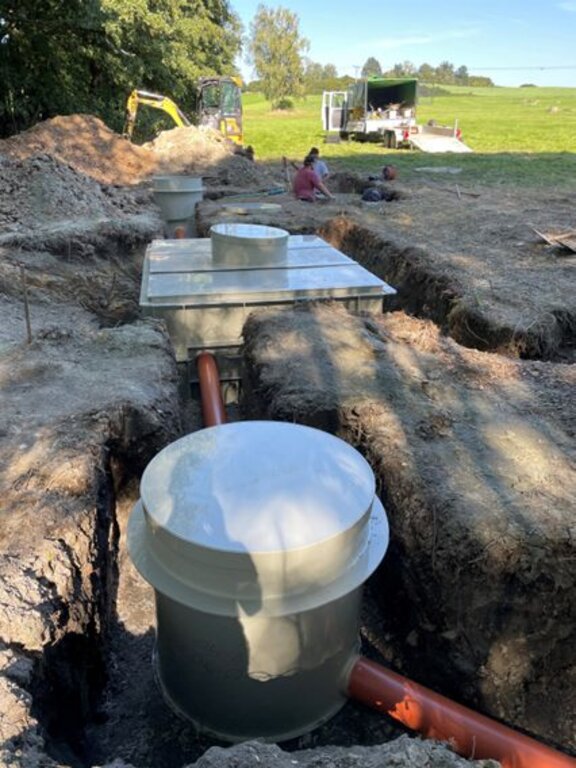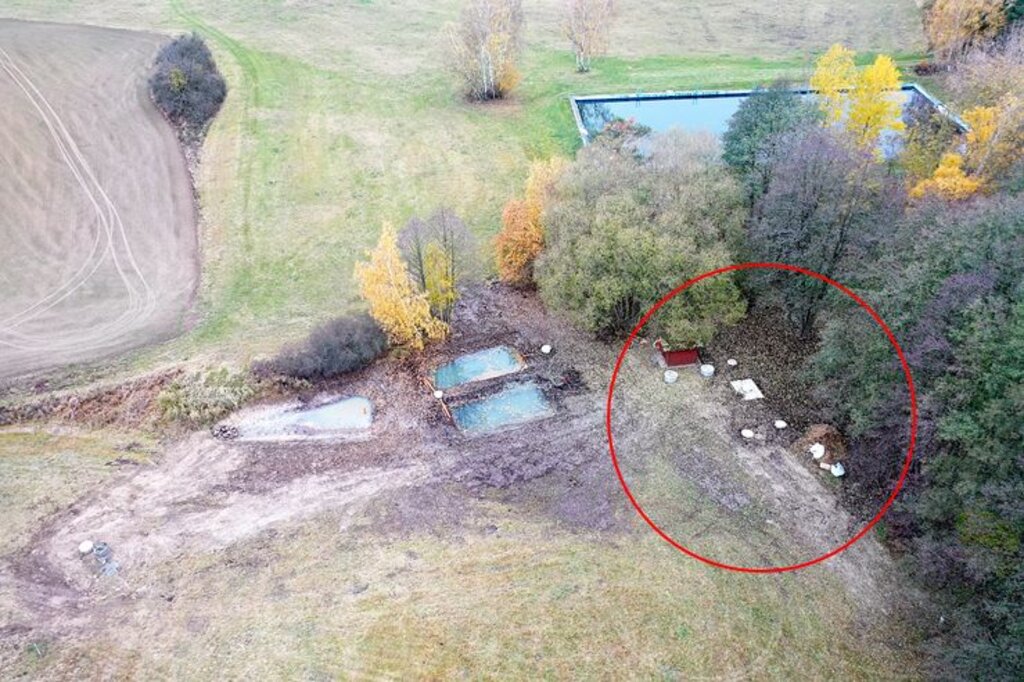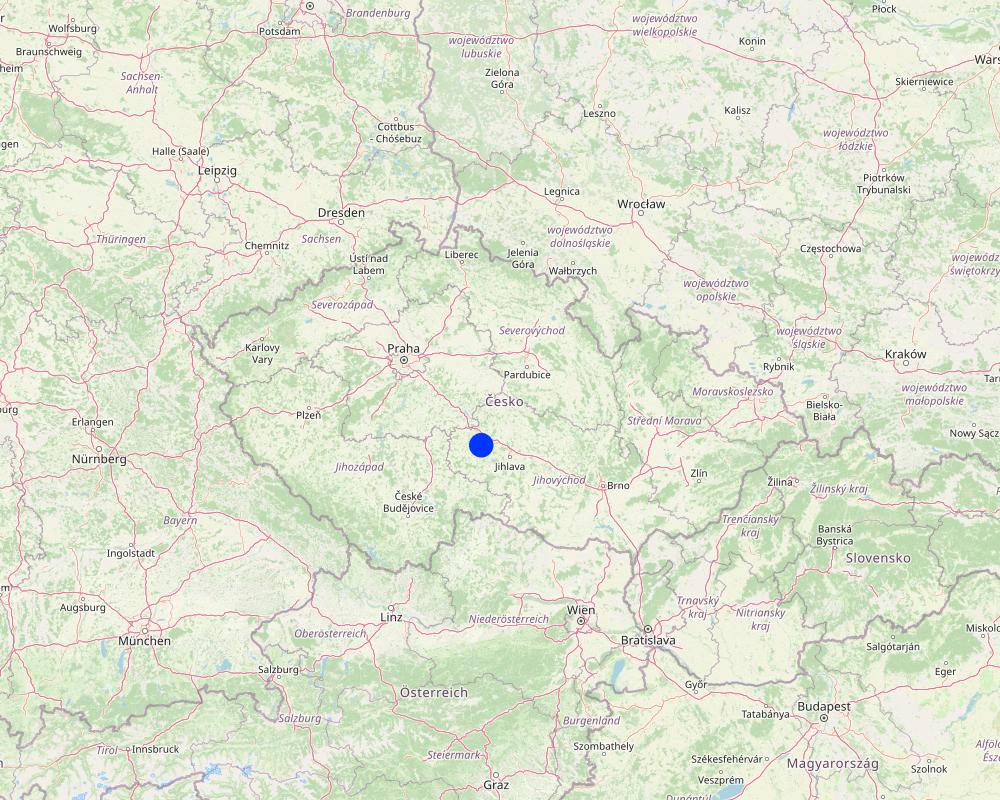Drainage Biofilter [សាធារណរដ្ឋឆែក]
- ការបង្កើត៖
- បច្ចុប្បន្នភាព
- អ្នកចងក្រង៖ Antonín Zajíček
- អ្នកកែសម្រួល៖ –
- អ្នកត្រួតពិនិត្យច្រើនទៀត៖ William Critchley, Rima Mekdaschi Studer
Drenážní biofiltr
technologies_6259 - សាធារណរដ្ឋឆែក
ពិនិត្យមើលគ្រប់ផ្នែក
ពង្រីកមើលទាំងអស់ បង្រួមទាំងអស់1. ព័ត៌មានទូទៅ
1.2 ព័ត៌មានលម្អិតពីបុគ្គលសំខាន់ៗ និងស្ថាប័នដែលចូលរួមក្នុងការវាយតម្លៃ និងចងក្រងឯកសារនៃបច្ចេកទេស
ឈ្មោះគម្រោងដែលបានចងក្រងឯកសារ/ វាយតម្លៃលើបច្ចេកទេស (បើទាក់ទង)
OPtimal strategies to retAIN and re-use water and nutrients in small agricultural catchments across different soil-climatic regions in Europe (OPTAIN)ឈ្មោះគម្រោងដែលបានចងក្រងឯកសារ/ វាយតម្លៃលើបច្ចេកទេស (បើទាក់ទង)
Approaches for design and realization of complex effective measures for tile drained agricultural catchments by land consolidations (QK21010341)ឈ្មោះអង្គភាពមួយ (ច្រើន) ដែលបានចងក្រងឯកសារ/ វាយតម្លៃបច្ចេកទេស (បើទាក់ទង)
Research Institute for Soil and Water Conservation (VUMOP) - សាធារណរដ្ឋឆែក1.3 លក្ខខណ្ឌទាក់ទងទៅនឹងការប្រើប្រាស់ទិន្នន័យដែលបានចងក្រងតាមរយៈ វ៉ូខេត
អ្នកចងក្រង និង(បុគ្គលសំខាន់ៗ)យល់ព្រមទទួលយកនូវលក្ខខណ្ឌនានាទាក់ទងទៅនឹងការប្រើប្រាស់ទិន្នន័យដែលបានចងក្រងតាមរយៈវ៉ូខេត:
បាទ/ចា៎
1.4 សេចក្តីប្រកាសស្តីពីចីរភាពនៃការពណ៌នាពីបច្ចេកទេស
តើបច្ចេកទេសដែលបានពណ៌នានេះមានបញ្ហាដែលផ្តោតលើការធ្លាក់ចុះគុណភាពដី, បើដូច្នេះវាមិនអាចត្រូវបានប្រកាសថាជាបច្ចេកទេសនៃការគ្រប់គ្រងប្រកបដោយចីរភាពទេ?
ទេ
មតិយោបល់:
The advantage of the drainage biofilter is that it occupies only a relatively small area and only minimally impedes soil cultivation
1.5 ការយោងទៅលើកម្រងបញ្ជីសំណួរ (មួយ ឬច្រើន) នៃវិធីសាស្ត្រផ្សព្វផ្សាយ SLM (ដែលបានចងក្រងដោយទស្សនៈពិភពលោកស្តីពីវិធីសាស្ត្រ និងបច្ចេកទេសងអភិរក្ស WOCAT)
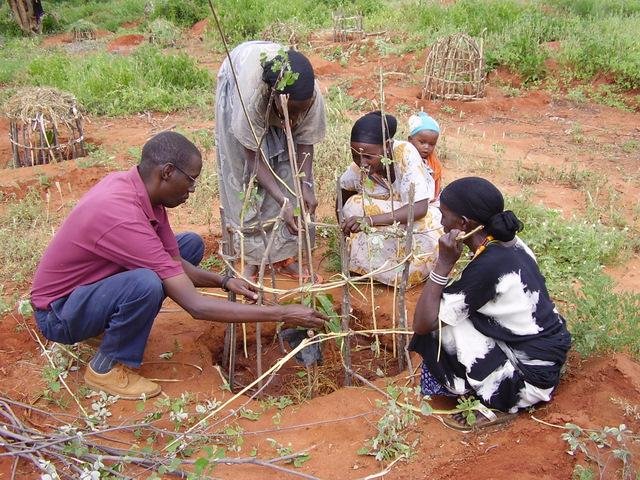
Catchment Approach [ប្រទេសកេនយ៉ា]
A focused approach to integrated land and water management, including soil and water conservation, where the active participation of the villagers - often organised through common interest groups - is central.
- អ្នកចងក្រង៖ James Gatero Njuki
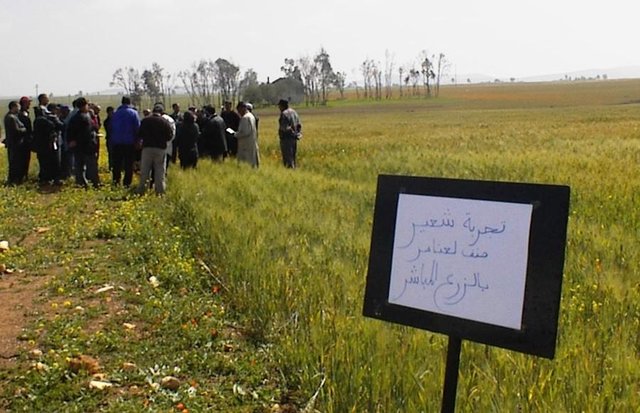
Applied research and knowledge transfer [ប្រទេសម៉ារ៉ុក]
Innovative, cross-disciplinary community-based approach for development and transfer of no-till technology at the farm level.
- អ្នកចងក្រង៖ Rachid Mrabet
2. ការពណ៌នាពីបច្ចេកទេស SLM
2.1 ការពណ៌នាដោយសង្ខេបពីបច្ចេកទេស
និយមន័យបច្ចេកទេស:
Biofilters or “bioreactors” connected to agricultural tile drains are relatively inexpensive and space-saving measures with considerable potential to improve the quality of drainage water.
2.2 ការពណ៌នាលម្អិតពីបច្ចេកទេស
ការពណ៌នា:
A biofilter or “bioreactor” is a relatively small installation used to break down pollutants from drainage water. Its basic function is to allow the passage of drainage water, contaminated with nutrients and pesticides, through a container with pollutant-reducing agents. Bioreactors are usually located at the bottom of agricultural drainage structures on the drains or in connection with drainage outlets. Ideally, the biofilter is located on a site that is no longer part of the cultivated land or is under permanent grassland.
In principle, two biofilter solutions are possible. In the case of low and regular drainage flows, the drainage section is directly replaced by a biofilter. With higher flows and in the case of rapid response of the drainage structure to rainfall-runoff episodes, the biofilter is placed parallel to the outlet drain or is located under the drainage outlet (if ambient conditions allow). Such a design includes a distribution structure (preferably located in a drainage manhole) and a drainage pipe to allow safe bypassing of a portion of the elevated drainage outlet, to maintain the residence time of the water in the biofilter and thus its corresponding efficiency.
The biofilter may be designed as closed or open. A closed biofilter is completely buried and normal tillage can take place. An open biofilter lacks the advantage of an undisturbed terrain but has the advantage of benefitting from plants that enhance the purification of drainage water by bacteria living on their roots.
The installation always consists of a bed or container in which the reducing agent is enclosed, ensuring the isolation of the agent from the surrounding soil and water. In the case of a smaller sized closed biofilter, a plastic container can be used, while in the case of a larger or open design, plastic film can be used as a bed. Various materials can be used as biofilter fillings, or substrates, both individually and in combination. In most cases, the reducing agent is carbonaceous, with denitrification mediated by chemo-organotrophic bacteria.
In terms of N-NO3 removal, the most effective are wood chips, which have a high hydraulic conductivity and a C:N ratio of 30:1 to 300:1. In particular, chips from poplar, pine and larch are suitable. For the removal of pesticides or biopharmaceuticals, then biochar (biochar) and lignite are suitable as natural and readily available materials. A combination of materials can also be used. For example, the addition of biochar to the wood chips will increase the efficiency of the bioreactor in degrading pesticides, or the charge can be combined with an inorganic substrate (sand, vermiculite), which is added to prevent undesirable settling, reduce hydraulic conductivity and at the same time mechanically purify the drainage water.
2.3 រូបភាពនៃបច្ចេកទេស
2.5 ប្រទេស/តំបន់/ទីតាំងកន្លែង ដែលបច្ចេកទេសត្រូវបានអនុវត្ត និងបានគ្រប់ដណ្តប់ដោយការវាយតម្លៃនេះ
ប្រទេស:
សាធារណរដ្ឋឆែក
តំបន់/រដ្ឋ/ខេត្ត:
Vysočina region (Highlands Region)
បញ្ជាក់បន្ថែមពីលក្ខណៈនៃទីតាំង:
Černičí, Dehtáře
បញ្ជាក់ពីការសាយភាយនៃបច្ចេកទេស:
- អនុវត្តនៅកន្លែងជាក់លាក់មួយ/ ប្រមូលផ្តុំនៅតំបន់តូចៗ
តើបច្ចេកទេស (មួយ ឬច្រើន) ទាំងនោះស្ថិតនៅក្នុងតំបន់ការពារជាអចិន្ត្រៃយ៍ណាមួយដែរឬទេ?
ទេ
Map
×2.6 កាលបរិច្ឆេទនៃការអនុវត្ត
ប្រសិនបើមិនច្បាស់ឆ្នាំ សូមបញ្ជាក់កាលបរិច្ឆេទដែលប្រហាក់ប្រហែល:
- តិចជាង 10ឆ្នាំមុន (ថ្មី)
2.7 ការណែនាំពីបច្ចេកទេស
សូមបញ្ជាក់តើបច្ចេកទេសត្រូវបានណែនាំឱ្យអនុវត្តដោយរបៀបណា:
- ពេលកំពុងពិសោធន៍
- តាមរយៈគម្រោង / អន្តរាគមន៍ពីខាងក្រៅ
មតិយោបល់ (ប្រភេទនៃគម្រោង ។ល។):
Several biofilters have already been implemented as part of research projects, and the development of a standardized, efficient and easy-to-implement solution is currently underway.
3. ចំណាត់ថ្នាក់នៃបច្ចេកទេស SLM
3.1 គោលបំណងចម្បង (១ ឬច្រើន) នៃបច្ចេកទេសនេះ
- ការពារតំបន់ទីជម្រាល/តំបន់ខ្សែទឹកខាងក្រោមបញ្ចូលជាមួយបច្ចេកទេសផ្សេងទៀត
- អភិរក្ស/ធ្វើឱ្យប្រសើរឡើងជីវចម្រុះ
- reduce diffusive agricultural pollution
3.2 ប្រភេទដីប្រើប្រាស់មួយប្រភេទ (ច្រើនប្រភេទ) ដែលបានអនុវត្តបច្ចេកទេស
ដីប្រើប្រាស់ចម្រុះនៅលើដីតែមួយ:
ទេ

ដីដាំដំណាំ
- ដំណាំរយៈពេលវែង (មិនមែនឈើ)
ដំណាំរយៈពេលវែង (មិនមែនឈើ) - បញ្ជាក់ប្រភេទដំណាំ:
- ដំណាំចំណីសត្វ - ស្មៅ
ចំនួនសារដែលដាំដំណាំក្នុងមួយឆ្នាំ:
- 1
តើជាការអនុវត្តន៍ដំណាំចន្លោះ?
ទេ
តើជាការអនុវត្តន៍ដំណាំវិលជុំ?
ទេ

ផ្លូវទឹក ផ្ទៃទឹក ដីសើម
- ខ្សែទឹក ផ្លូវទឹក
3.3 បន្ទាប់ពីអនុវត្តបច្ចេកទេស តើដីប្រើប្រាស់មានការប្រែប្រួលដែររឺទេ?
បន្ទាប់ពីអនុវត្តបច្ចេកទេស តើដីប្រើប្រាស់មានការប្រែប្រួលដែររឺទេ?
- បាទ/ច៎ា (សូមបំពេញសំណួរខាងក្រោមពីស្ថានភាពដីប្រើប្រាស់មុនពេលអនុវត្តបច្ចេកទេស)

ដីដាំដំណាំ
- ដំណាំប្រចាំឆ្នាំ
ដំណាំប្រចាំឆ្នាំ - បញ្ជាក់ប្រភេទដំណាំ:
- ធញ្ញជាតិ - ស្រូវ
- ធញ្ញជាតិ - ពោត
- ធញ្ញជាតិ - ស្រូវសាលី (សិសិររដូវរងារ)
- ដំណាំដែលមានគ្រាប់ចម្រាញ់ប្រេងបាន - ផ្កាឈូករ័ត្ន ផ្កា rapeseed ផ្សេងៗ
- ឬស/ដំណាំមើម - ដំឡូងបារាំង
តើជាការអនុវត្តន៍ដំណាំចន្លោះ?
បាទ/ចា៎
ប្រសិនបើបាទ/ច៎ា សូមបញ្ជាក់ប្រភេទដំណាំដែលដាំចន្លោះគ្នានោះ:
In some seasons, spring cereal mix, legume-cereal mix or undersown clover is used as an intercrop
តើជាការអនុវត្តន៍ដំណាំវិលជុំ?
បាទ/ចា៎
បើបាទ/ច៎ា សូមបញ្ជាក់:
five-years or seven-years crop rotation containinng winter cereals, spring cereals, potatoes, red clover, oil seed rape and maize
3.4 ការផ្គត់ផ្គង់ទឹក
ការផ្គត់ផ្គង់ទឹកនៅកន្លែងអនុវត្តបច្ចេកទេស:
- ទឹកភ្លៀង
3.5 ក្រុម SLM ដែលបច្ចេកទេសស្ថិតនៅក្នុង
- ការគ្រប់គ្រងទឹកលើដី (ទឹកធ្លាក់ ទន្លេ បឹង សមុទ្រ)
- ការគ្រប់គ្រងទឹកក្រោមដី
3.6 វិធានការ SLM ដែលបញ្ចូលនូវបច្ចេកទេស

វិធានការរុក្ខជាតិ
- V2: ស្មៅនិងរុក្ខជាតិៗដែលដុះមានអាយុមិនលើសពី 2ឆ្នាំ

វិធានការរចនាស័ម្ពន្ធ
- S11: ផ្សេងៗ
3.7 កំណត់ប្រភេទនៃការធ្លាក់ចុះគុណភាពដីសំខាន់ៗដែលបច្ចេកទេសនេះបានដោះស្រាយ

ការបាត់បង់ទឹក
- Hp: ការថយចុះគុណភាពទឹកនៅលើផ្ទៃដី
- Hq: ការថយចុះគុណភាពទឹកនៅក្រោមដី
3.8 ការពារ កាត់បន្ថយ ឬស្តារឡើងវិញនៃការធ្លាក់ចុះគុណភាពដី
បញ្ជាក់ពីគោលដៅរបស់បច្ចេកទេស ដែលផ្តោតទៅការធ្លាក់ចុះគុណភាពដី:
- ដែលមិនអាចអនុវត្តបាន
មតិយោបល់:
This measure is primarily aimed at improving water quality.
4. បច្ចេកទេសជាក់លាក់ សកម្មភាពអនុវត្ត ធាតុចូល និងថ្លៃដើម
4.1 គំនូសបច្ចេកទេសនៃបច្ចេកទេសនេះ
លក្ខណៈពិសេសនៃបច្ចេកទេស (ទាក់ទងនឺងគំនូរបច្ចេកទេស):
The drawing shows a closed biofilter/bioreactor system, which is built as a bypass of the existing drainage pipe. The measure is looped at the bottom of the drainage system to approximate the recipient.
This system consists mainly of the following features:
1) Drainage water inlet - existing drainage pipe - tile drains
2) Flow control facillity, which is built on top of the existing drainage pipe. The main line structure was excavated, the original ceramic pipe was replaced with a plastic PP pipe and a manhole with an embedded baffle was inserted to allow the water to rise to the required level and subsequently overflow the excess water over the overflow edge. A control element is placed in the manhole to regulate the flow of water into the system.
3) The existing drain, which, once the measures are constructed, serves as a bypass for excess runoff during spring thaw or significant rainfall-runoff episodes.
4) Inflow to the biofilter in the form of a newly constructed pipe.
5) Bed of biofilter - a hardened bed to prevent destruction of the biofilter by shallow groundwater levels and a plastic container for the actual biofilter fill.
6) Biofilter fill. I.n this case a mixture of vermiculite, wood chips and biochar, alternatively wood chips themselves or other materials can be used
7) Purified water outlet from the biofilter
8) Flow control facility, built in drainage manhole, purified water is returned to the existing drainage pipe
9) Drainage outlet
ឈ្មោះអ្នកនិពន្ធ:
Research Institute for Soil and Water Conservation
កាលបរិច្ឆេទ:
01/02/2023
4.2 ព័ត៌មានទូទៅដែលពាក់ព័ន្ធនឹងការគណនាធាតុចូល និងថ្លៃដើម
កំណត់របៀបនៃការគណនាថ្លៃដើម និងធាតុចូល:
- ក្នុងឯកតាបច្ចេកទេស
បញ្ជាក់ឯកតា:
measure - one system of closed biofilter/bioreactor
ផ្សេងៗ/ រូបិយប័ណ្ណជាតិ (បញ្ជាក់):
EUR
បើពាក់ព័ន្ធសូមកំណត់អត្រាប្តូរប្រាក់ពីដុល្លាទៅរូបិយប័ណ្ណតំបន់ (ឧ. 1 ដុល្លារ = 79.9 រៀលនៃរូបិយប័ណ្ណប្រេស៊ីល) ៖ 1 ដុល្លារ =:
0,92
កំណត់ថ្លៃឈ្នួលជាមធ្យមនៃការជួលកម្លាំងពលកម្មក្នុងមួយថ្ងៃ:
150
4.3 សកម្មភាពបង្កើត
| សកម្មភាព | រយៈពេល (រដូវកាល) | |
|---|---|---|
| 1. | Selecting proper place for the measure | Before implementation |
| 2. | Obtaining the consent of the owners and users of the affected land | Before implementation |
| 3. | Project documentation | Before implementation |
| 4. | Water management office permisiond and building permission | Before implementation |
| 5. | Excavation works | Drier period, ideally at the end of the growing season |
| 6. | Biofilter construction | Drier period, ideally at the end of the growing season |
| 7. | Filling the biofilter with substrates | Drier period, ideally at the end of the growing season |
4.4 ថ្លៃដើម និងធាតុចូលដែលត្រូវការសម្រាប់ការបង្កើតបច្ចេកទេស
| បញ្ជាក់ពីធាតុចូល | ឯកតា | បរិមាណ | ថ្លៃដើមក្នុងមួយឯកតា | ថ្លៃធាតុចូលសរុប | % នៃថ្លៃដើមដែលចំណាយដោយអ្នកប្រើប្រាស់ដី | |
|---|---|---|---|---|---|---|
| កម្លាំងពលកម្ម | Project/design | person-days | 5,0 | 200,0 | 1000,0 | 100,0 |
| កម្លាំងពលកម្ម | Engineering | person-days | 10,0 | 200,0 | 2000,0 | 100,0 |
| កម្លាំងពលកម្ម | Implementation of the measure | person-days | 6,0 | 150,0 | 900,0 | 100,0 |
| សម្ភារៈ | Tansport of material | machine-days | 5,0 | 150,0 | 750,0 | 100,0 |
| សម្ភារៈ | Excavation works | machine-days | 3,0 | 220,0 | 660,0 | 100,0 |
| សម្ភារៈដាំដុះ | grasss seeding | kg | 10,0 | 8,0 | 80,0 | 100,0 |
| សម្ភារៈសាងសង់ | Distribution object (manhole) | piece | 2,0 | 2200,0 | 4400,0 | 100,0 |
| សម្ភារៈសាងសង់ | Container for filling the biofilter | piece | 1,0 | 2400,0 | 2400,0 | 100,0 |
| សម្ភារៈសាងសង់ | Sorbents (vermukulit, biochar, woodchips) | m3 | 3,0 | 440,0 | 1320,0 | 100,0 |
| សម្ភារៈសាងសង់ | drainage pipes and other material | m | 20,0 | 2,0 | 40,0 | 100,0 |
| ថ្លៃដើមសរុបក្នុងការបង្កើតបច្ចេកទេស | 13550,0 | |||||
| ថ្លៃដើមសរុបក្នុងការបង្កើតបច្ចេកទេសគិតជាដុល្លារ | 14728,26 | |||||
ប្រសិនបើអ្នកប្រើប្រាស់ដីមិនមានថ្លៃដើម 100% សូមបញ្ជាក់ថានរណាដែលចំណាយថ្លៃដើមដែលនៅសល់:
co-financing from public sources
មតិយោបល់:
Under certain conditions, owners and users of land, regardless of their legal form, municipalities and other public entities may apply for a subsidy for the implementation of this measure, which is provided by the Ministry of the Environment of the Czech Republic
The subsidy is up to 100 % of the total eligible expenditure, the minimum eligible direct implementation expenditure per project is set at CZK 250 000 ( 10 000 EUR), excluding VAT.
4.5 សកម្មភាពថែទាំ
| សកម្មភាព | ពេលវេលា/ ភាពញឹកញាប់ | |
|---|---|---|
| 1. | Exchange of reducing agent in biofilter | every 5 - 10 years |
| 2. | Cutting the grass aroun the measure | twice a year |
| 3. | Checking and maintenance/repairs | once a year |
4.6 កំណត់ថ្លៃដើមសម្រាប់ការថែទាំ/ សកម្មភាពរបស់បច្ចេកទេស (ក្នុងរយៈពេលមួយឆ្នាំ)
| បញ្ជាក់ពីធាតុចូល | ឯកតា | បរិមាណ | ថ្លៃដើមក្នុងមួយឯកតា | ថ្លៃធាតុចូលសរុប | % នៃថ្លៃដើមដែលចំណាយដោយអ្នកប្រើប្រាស់ដី | |
|---|---|---|---|---|---|---|
| កម្លាំងពលកម្ម | grass chopper | machine days | 1,0 | 100,0 | 100,0 | 100,0 |
| សម្ភារៈដាំដុះ | grasss seed | kg | 10,0 | 8,0 | 80,0 | 100,0 |
| ថ្លៃដើមសរុបសម្រាប់ការថែទាំដំណាំតាមបច្ចេកទេស | 180,0 | |||||
| ថ្លៃដើមសរុបសម្រាប់ការថែទាំដំណាំតាមបច្ចេកទេសគិតជាដុល្លារ | 195,65 | |||||
មតិយោបល់:
It is necessary to replace the sorbent once every 5 years to once every 10 years. The price of sorbents (vermiculite, biochar, woodchips) EUR 1320 for ca 3 cubic meters needed. The price for transportation and switching of old and new sorbents is ca EUR 300.
4.7 កត្តាសំខាន់បំផុតដែលមានឥទ្ធិពលដល់ការចំណាយ
ពណ៌នាពីកត្តាប៉ះពាល់ចម្បងៗទៅលើថ្លៃដើម:
The price of this measure is mostly influenced by its dimensioning for a certain water residence time of the drainage runoff (the above described example is dimensioned for a delay period of about 12 hours at a maximum drainage flow of 0.5 l/s). Another factor is the price of sorbents, where biochar and vermiculite in particular are quite expensive (approximately 250 EUR/m3). Alternatively, woodchips can be used (80 EUR/m3). The price can also be reduced by a simpler construction of the biofilter bed. The minimum price for this measure is estimated at EUR 3 200.
5. លក្ខណៈបរិស្ថានធម្មជាតិ និងមនុស្ស
5.1 អាកាសធាតុ
បរិមាណទឹកភ្លៀងប្រចាំឆ្នាំ
- < 250 មម
- 251-500 មម
- 501-750 មម
- 751-1,000 មម
- 1,001-1,500 មម
- 1,501-2,000 មម
- 2,001-3,000 មម
- 3,001-4,000 មម
- > 4,000 មម
កំណត់បរិមាណទឹកភ្លៀង (បើដឹង) ជា មីលីម៉ែត្រ:
666,00
លក្ខណៈពិសេស/ មតិយោបល់លើរដូវភ្លៀង:
Total precipitation during the vegetation
period ranges between 350 and 450 mm, and in the
winter months between 250 and 300 mm, with a total annual
average of 666 mm.
បញ្ជាក់ឈ្មោះឯកសារយោងនៃស្ថានីយឧតុនិយម:
Košetice, own measurement
តំបន់កសិអាកាសធាតុ
- មានភ្លៀងមធ្យម
mean average temperature 7,9 °C
5.2 សណ្ឋានដី
ជម្រាលជាមធ្យម:
- រាបស្មើ (0-2%)
- ជម្រាលតិចតួច (3-5%)
- មធ្យម (6-10%)
- ជម្រាលខ្ពស់បន្តិច (11-15%)
- ទីទួល (16-30%)
- ទីទួលចោត (31-60%)
- ទីទួលចោតខ្លាំង (>60%)
ទម្រង់ដី:
- ខ្ពង់រាប
- កំពូលភ្នំ
- ជម្រាលភ្នំ
- ជម្រាលទួល
- ជម្រាលជើងភ្នំ
- បាតជ្រលងភ្នំ
តំបន់តាមរយៈកម្ពស់ :
- 0-100 ម
- 101-500 ម
- 501-1,000 ម
- 1,001-1,500 ម
- 1,501-2,000 ម
- 2,001-2,500 ម
- 2,501-3,000 ម
- 3,001-4,000 ម
- > 4,000 ម
បញ្ជាក់ថាតើបច្ចេកទេសនេះត្រូវបានអនុវត្តន៍នៅក្នុង:
- សណ្ឋានដីប៉ោង
មតិយោបល់ និងបញ្ចាក់បន្ថែមអំពីសណ្ឋានដី :
The altitude varies between 549.8 and 497 m asl., The substrate is formed by partially
migmatized paragneiss in various degrees of degradation.
Quaternary sediments are represented by slope sands and
loams reaching 1–2 m thickness.
5.3 ដី
ជម្រៅដីជាមធ្យម:
- រាក់ខ្លាំង (0-20 សម)
- រាក់ (21-50 សម)
- មធ្យម (51-80 សម)
- ជ្រៅ (81-120 សម)
- ជ្រៅខ្លាំង (> 120 សម)
វាយនភាពដី (ស្រទាប់លើ):
- មធ្យម (ល្បាយ, ល្បាប់)
វាយនភាពដី (> 20 សម ស្រទាប់ក្នុង):
- មធ្យម (ល្បាយ, ល្បាប់)
- ម៉ត់/ ធ្ងន់ (ឥដ្ឋ)
សារធាតុសរីរាង្គនៅស្រទាប់ដីខាងលើ:
- មធ្យម (1-3%)
បើអាចសូមភ្ជាប់ការពណ៌នាពីដីឱ្យបានច្បាស់ ឬព័ត៌មានដែលអាចទទួលបាន ឧ. ប្រភេទដី, pH ដី/ ជាតិអាស៊ីត, សមត្ថភាពផ្លាស់ប្តូរកាចុង, វត្តមាននីត្រូសែន, ភាពប្រៃ ។ល។:
The representation of soils
(according to the World Reference Base for Soil Resources
2006) is variable, with Gleyed Cambisols, Gleysols, and
sporadically Histosols. In the recharge area, the soil cover is
more homogenous, with prevailing Modal, Ranker and
Arenic Cambisols.
5.4 ទឹកដែលអាចទាញមកប្រើប្រាស់បាន និងគុណភាពទឹក
នីវ៉ូទឹកក្រោមដី:
< 5 ម
ទឹកលើដីដែលអាចទាញយកប្រើប្រាស់បាន:
ល្អ
គុណភាពទឹក (មិនបានធ្វើប្រត្តិកម្ម):
ទឹកសម្រាប់តែការធ្វើកសិកម្ម (ស្រោចស្រព)
គុណភាពទឹក គឺផ្តោតទៅលើ៖:
ទាំងទឹកក្រោមដី និងលើផ្ទៃដី
តើមានបញ្ហាភាពទឹកប្រៃហូរចូលមកដែរឬទេ?
ទេ
តើទឹកជំនន់កំពុងកើតមាននៅតំបន់នេះដែររឺទេ?
ទេ
មតិយោបល់ និងលក្ខណៈពិសេសផ្សេងៗទៀតលើគុណភាព និងបរិមាណទឹក :
Water quality is threatened by non-point source (agricultural) pollution, in particular by increased leaching of nitrate nitrogen and pesticides and their metabolites
5.5 ជីវៈចម្រុះ
ភាពសម្បូរបែបនៃប្រភេទ:
- កម្រិតមធ្យម
ភាពសម្បូរបែបនៃទីជម្រក:
- កម្រិតមធ្យម
5.6 លក្ខណៈនៃអ្នកប្រើប្រាស់ដីដែលអនុវត្តបច្ចេកទេស
នៅមួយកន្លែង ឬពនេចរ :
- នៅមួយកន្លែង
ទីផ្សារនៃប្រព័ន្ធផលិតកម្ម:
- ពាណិជ្ជកម្ម/ ទីផ្សារ
ចំណូលក្រៅកសិកម្ម:
- តិចជាង 10% នៃចំណូល
កម្រិតជីវភាព:
- មធ្យម
- មាន
ឯកជន ឬក្រុម:
- សហករ
- មានបុគ្គលិក (ក្រុមហ៊ុន, រដ្ឋ)
កម្រិតប្រើប្រាស់គ្រឿងយន្ត:
- គ្រឿងយន្ត/ ម៉ាស៊ីន
យេនឌ័រ:
- ស្ត្រី
- បុរស
អាយុរបស់អ្នកប្រើប្រាស់ដី:
- យុវវ័យ
- វ័យកណ្តាល
- មនុស្សចាស់
5.7 ទំហំផ្ទៃដីជាមធ្យមនៃដីប្រើប្រាស់ដោយអ្នកប្រើប្រាស់ដី ក្នុងការអនុវត្តបច្ចេកទេស
- < 0.5 ហិកតា
- 0.5-1 ហិកតា
- 1-2 ហិកតា
- 2-5 ហិកតា
- 5-15 ហិកតា
- 15-50 ហិកតា
- 50-100 ហិកតា
- 100-500 ហិកតា
- 500-1,000 ហិកតា
- 1,000-10,000 ហិកតា
- > 10,000 ហិកតា
តើផ្ទៃដីនេះចាត់ទុកជាទំហំកម្រិតណាដែរ ខ្នាតតូច មធ្យម ឬខ្នាតធំ (ធៀបនឹងបរិបទតំបន់)?
- ខ្នាតមធ្យម
មតិយោបល់:
The Czech Republic is characterised by a significant size of agricultural holdings. During the socialist era (1948-1989), large agricultural cooperatives were established. Today, most agricultural land is still farmed by similar enterprises, whether in the form of cooperatives, limited liability companies or joint stock companies.
5.8 ភាពជាម្ចាស់ដី កម្មសិទ្ធប្រើប្រាស់ដី និងកម្មសិទ្ធប្រើប្រាស់ទឹក
ភាពជាម្ចាស់ដី:
- ក្រុមហ៊ុន
- ភូមិ
កម្មសិទ្ធិប្រើប្រាស់ដី:
- កិច្ចសន្យាជួល
- ឯកជន
កម្មសិទ្ធប្រើប្រាស់ទឹក:
- អាស្រ័យផលសេរី (មិនមានការកំណត់)
តើកម្មសិទ្ធប្រើប្រាស់ដី គឺផ្អែកលើប្រព័ន្ធច្បាប់បែបបុរាណ?
ទេ
5.9 ការប្រើប្រាស់សេវាកម្ម និងហេដ្ឋារចនាសម្ព័ន្ធ
សុខភាព:
- មិនល្អ
- មធ្យម
- ល្អ
ការអប់រំ:
- មិនល្អ
- មធ្យម
- ល្អ
ជំនួយបច្ចេកទេស:
- មិនល្អ
- មធ្យម
- ល្អ
ការងារ (ឧ. ការងារក្រៅកសិដ្ឋាន):
- មិនល្អ
- មធ្យម
- ល្អ
ទីផ្សារ:
- មិនល្អ
- មធ្យម
- ល្អ
ថាមពល:
- មិនល្អ
- មធ្យម
- ល្អ
ផ្លូវ និងការដឹកជញ្ជូន:
- មិនល្អ
- មធ្យម
- ល្អ
ទឹកផឹក និងអនាម័យ:
- មិនល្អ
- មធ្យម
- ល្អ
សេវាកម្មហិរញ្ញវត្ថុ:
- មិនល្អ
- មធ្យម
- ល្អ
6. ផលប៉ះពាល់ និងការសន្និដ្ឋាន
6.1 ផលប៉ះពាល់ក្នុងបរិវេណអនុវត្តបច្ចេកទេសដែលកើតមាន
ផលប៉ះពាល់ទៅលើអេកូឡូស៊ី
វដ្តទឹក/លំហូរ
បរិមាណទឹក
មតិយោបល់/ ការបញ្ជាក់:
Slowing of the drainage runoff will be noticeable especially during normal and lower discharges
គុណភាពទឹក
មតិយោបល់/ ការបញ្ជាក់:
The effects of the measures are particularly positive in terms of reducing nutrient (nitrogen, phosphorus) and pesticide concentrations
6.2 ផលប៉ះពាល់ក្រៅបរិវេណអនុវត្តបច្ចេកទេសដែលកើតមាន
ទឹកក្រោមដី/ ការបំពុលទឹកទន្លេ
មតិយោបល់/ ការបញ្ជាក់:
The effect of biofilter-type measures is particularly pronounced in small intensively drained agricultural catchments where much of the runoff (and pollution) comes from drainage waters
6.3 ភាពប្រឈម និងភាពរួសនៃបច្ចេកទេសទៅនឹងការប្រែប្រួលអាកាសធាតុ និងគ្រោះអាកាសធាតុ/ គ្រោះមហន្តរាយ (ដែលដឹងដោយអ្នកប្រើប្រាស់ដី)
ផលវិបាកដែលទាក់ទងនឹងបរិយាកាសផ្សេងៗទៀត
ផលវិបាកដែលទាក់ទងនឹងបរិយាកាសផ្សេងៗទៀត
| លក្ខណៈឆ្លើយតបនៃបច្ចេកទេសទៅនឹងការប្រែប្រួលអាកាសធាតុ | |
|---|---|
| Irregular rainfall distribution and increasing number of runoff episodes | មធ្យម |
មតិយោបល់:
A sudden increase in drainage flow during a rainfall-runoff episode may cause a short-term reduction in the effectiveness of the measures, whereby the residence time of water in the biofilter may be reduced and also a portion of the drainage runoff flows untreated through the bypass
6.4 ការវិភាគថ្លៃដើម និងអត្ថប្រយោជន៍
តើផលចំណេញ និងថ្លៃដើមត្រូវបានប្រៀបធៀបគ្នាយ៉ាងដូចម្តេច (ទស្សនៈរបស់អ្នកប្រើប្រាស់ដី)?
រយៈពេលខ្លី:
អវិជ្ជមានតិចតួច
រយៈពេលវែង:
វិជ្ជមានតិចតួច
តើផលចំណេញ និងការថែទាំ/ ជួសជុលត្រូវបានប្រៀបធៀបគ្នាយ៉ាងដូចម្តេច (ទស្សនៈរបស់អ្នកប្រើប្រាស់ដី)?
រយៈពេលខ្លី:
ប៉ះពាល់តិចតួចបំផុត
រយៈពេលវែង:
ប៉ះពាល់តិចតួចបំផុត
6.5 ការទទួលយកបច្ចេកទេស
- តែមួយករណី /ពិសោធន៍
6.6 ការបន្សុំា
តើថ្មីៗនេះ បច្ចេកទេសនេះត្រូវបានកែតម្រូវដើម្បីបន្ស៊ាំទៅនឹងស្ថានភាពប្រែប្រួលដែរឬទេ?
បាទ/ចា៎
ផ្សេងៗ (សូមបញ្ជាក់):
treating of pesticide pollution
បញ្ជាក់ពីការបន្ស៊ាំនៃបច្ចេកទេស (ការរៀបចំ, ឧបករណ៍/ប្រភេទ ។ល។):
The use of biochar and other advanced materials as substrates will enable the use of bioreactors to reduce water pollution from pesticides and their metabolites
6.7 ភាពខ្លាំង/ គុណសម្បត្តិ/ ឱកាសនៃបច្ចេកទេស
| ភាពខ្លាំង/ គុណសម្បត្តិ/ ឱកាសនៅកន្លែងរបស់អ្នកប្រើប្រាស់ដី |
|---|
| Relatively small and cheap measure |
| The measure does not require frequent and costly maintenance |
| ភាពខ្លាំង/ គុណសម្បត្តិ/ ឱកាស ទស្សនៈរបស់បុគ្គលសំខាន់ៗ |
|---|
| High efficiency of drainage water treatment measures |
6.8 ភាពខ្សោយ/ គុណវិបត្តិ/ ហានិភ័យនៃបច្ចេកទេស និងវិធីសាស្ត្រដោះស្រាយ
| ភាពខ្សោយ/ គុណវិបត្តិ/ ហានិភ័យ ទស្សនៈរបស់អ្នកប្រើប្រាស់ដី | តើបច្ចេកទេសទាំងនោះបានដោះស្រាយបញ្ហាដូចម្តេច? |
|---|---|
| Difficult to obtain subsidies for construction | Change in subsidy polices |
| Often different owner and user of the land concerned |
| ភាពខ្សោយ/ គុណវិបត្តិ/ ហានិភ័យ ទស្សនៈរបស់អ្នកចងក្រងឬបុគ្គលសំខាន់ៗ | តើបច្ចេកទេសទាំងនោះបានដោះស្រាយបញ្ហាដូចម្តេច? |
|---|---|
| Reduced efficiency during significant rainfall-runoff events | Correct sizing of the measure. |
7. ឯកសារយោង និងវេបសាយ
7.1 វិធីសាស្ត្រ/ ប្រភពនៃព័ត៌មាន
- តាមការចុះទីវាល ការស្រាវជ្រាវនៅទីវាល
Long term research of the whole team
- ការសម្ភាសន៍ជាមួយអ្នកប្រើប្រាស់ដី
Discussion with several dozen farmers
- ការសម្ភាសន៍ជាមួយអ្នកជំនាញ/ ឯកទេស
Literature searches of scientific articles
តើពេលណាដែលទិន្នន័យបានចងក្រង (នៅទីវាល)?
2016
7.2 ឯកសារយោងដែលបានចេញផ្សាយ
ចំណងជើង អ្នកនិពន្ធ ឆ្នាំ ISBN:
ZAJÍČEK, A., SYCHRA, L., VYBÍRAL, T., HEJDUK, T., ČMELÍK, M., FUČÍK, P., KAPLICKÁ, M. 2021: Design of the Revitalization measures on the Main drainage facilities and hydrologically related Detailed drainage facilities (In Czech)
មានប្រភពមកពីណា? ថ្លៃដើមប៉ុន្មាន?
https://doi.org/10.3390/w15061247
ចំណងជើង អ្នកនិពន្ធ ឆ្នាំ ISBN:
Kvítek, T.; Zajíček, A.; Dostál, T.; Fučík, P.; Krása, J.; Bauer, M.; Jáchymová, B.; Kulhavý, Z.; Pavel, M. Slowing Down Quick Runoff—A New Approach for the Delineation and Assessment of Critical Points, Contributing Areas, and Proposals of Measures to Reduce Non-Point Water Pollution from Agricultural Land. Water 2023, 15, 1247.
មានប្រភពមកពីណា? ថ្លៃដើមប៉ុន្មាន?
https://doi.org/10.3390/w15061247
ចំណងជើង អ្នកនិពន្ធ ឆ្នាំ ISBN:
Vrchovecká, S., Asatiani, N., Antoš, V., Wacławek, S., Hrabák, P. (2023): et al. Study of Adsorption Efficiency of Lignite, Biochar, and Polymeric Nanofibers for Veterinary Drugs in WWTP Effluent Water. Water Air Soil Pollut 234, 268.
មានប្រភពមកពីណា? ថ្លៃដើមប៉ុន្មាន?
https://doi.org/10.1007/s11270-023-06281-0
ចំណងជើង អ្នកនិពន្ធ ឆ្នាំ ISBN:
Johnson, G. M.,Christianson, R. D., Cooke, R.A. C., Diaz-Garcia, C., Christianson, L. E. 2022. Denitrifying bioreactor woodchip sourcing guidance based on physical and hydraulic properties. ECOLOGICAL ENGINEERING, 184
មានប្រភពមកពីណា? ថ្លៃដើមប៉ុន្មាន?
DOI10.1016/j.ecoleng.2022.106791
ចំណងជើង អ្នកនិពន្ធ ឆ្នាំ ISBN:
Christianson, LE et al., 2021. EFFECTIVENESS OF DENITRIFYING BIOREACTORS ON WATER POLLUTANT REDUCTION FROM AGRICULTURAL AREAS,AGRICULTURAL ENGINEERINGAGRICULTURAL ENGINEERING
មានប្រភពមកពីណា? ថ្លៃដើមប៉ុន្មាន?
DOI10.13031/trans.14011
7.3 ការភ្ជាប់ទៅកាន់ព័ត៌មានពាក់ព័ន្ធលើប្រព័ន្ធអនឡាញ
ចំណងជើង/ ពណ៌នា:
Zajíček, A., Hejduk, T., Sychra, L., Vybíral, T., Fučík, P. (2022): How to Select a Location and a Design of Measures on Land Drainage – A Case Study from the Czech Republic. Journal of Ecological Engineering 2022, 23(4), 43–57. ISSN 2299–8993.
វេបសាយ:
https://doi.org/10.12911/22998993/146270
ការតភ្ជាប់ និងម៉ូឌុល
ពង្រីកមើលទាំងអស់ បង្រួមទាំងអស់ការតភ្ជាប់

Catchment Approach [ប្រទេសកេនយ៉ា]
A focused approach to integrated land and water management, including soil and water conservation, where the active participation of the villagers - often organised through common interest groups - is central.
- អ្នកចងក្រង៖ James Gatero Njuki

Applied research and knowledge transfer [ប្រទេសម៉ារ៉ុក]
Innovative, cross-disciplinary community-based approach for development and transfer of no-till technology at the farm level.
- អ្នកចងក្រង៖ Rachid Mrabet
ម៉ូឌុល
គ្មានម៉ូឌុល


